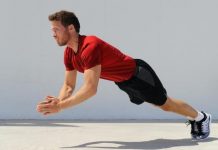If your workout plan doesn’t include strength training, here’s your chance to change that! Experts agree strength training is important, as science shows that incorporating just a few strength training sessions into your workout plan each week can help increase muscle mass, improve performance, burn calories and boost metabolisms for both men and women! No matter if you’re working towards losing a few pounds or building muscle, hitting the weights can help any body type. And with resistance training becoming more and more popular—especially for women—there are plenty of different methods to choose from. If your workouts typically revolve around treadmills, ellipticals, or other cardio machines, here are a few easy ways to get started with strength training:
Start with a full body workout. Different people break down their strength sessions differently, but for simplicity sake, start with a total body workout that hits each muscle of your entire body, instead of doing a workout that only targets your upper body, lower body, or abs. That way, you can squeeze in 1-2 strength workouts a week without missing a single muscle in your whole body. After a few weeks (or months), you can choose to switch your workouts up.
Choose bodyweight or light weights. When you’re just starting out with strength training, form is key; and the number one thing that can hinder your performance is using too much weight, too soon. Opt for bodyweight, or use lightweight or even resistance bands to avoid creating bad habits, or worse: a trip to the doctor! Take the time to focus on the actions, and how your body moves through each one. If you’re not sure whether you have the correct form, request help from a coach, or join strength classes led by an instructor—there are lots to try!
Feel comfortable leaning on other people for support. Wandering into the weight room for the first time can be intimidating—for both men and women. Just remember that you’re not alone! There are like-minded people all around you that want to see you succeed (including us). So if you have a question, ask a coach, instructor, or even another gym-goer. And if you’re lacking a little motivation? Find a fitness pal or join group fitness classes! Experts believe that working out with another person can increase your fitness performance by up to 200%. Wow! For more information, check out our tips for meeting people at the gym.
Full-Body Strength Training Workout
This quick workout will tone your muscles in your whole body, burn some calories, and rev up your metabolism—no matter your body type or fitness level!
Major Muscle Groups: Upper Body, Lower Body, Core
Equipment: Dumbbells, Mat, Bench (optional)
Directions: Complete one set of each exercise in the circuit (like a superset), before moving onto round two. Once you’ve finished four rounds of the first circuit, move to the second one and repeat. Remember that this is not a timed workout, so it’s not a race. You should give your all to each exercise and each set, and take however much time you need in between moves and rounds. Aim for 30-60 seconds between moves, and 60-90 seconds between rounds. You have the option to use heavy weights and allow yourself more recovery time in between exercise to build more muscle mass, or to work your cardio endurance and blast calories, use lighter weights and move quicker with less rest from exercise to exercise. Bottom line: just be sure to challenge yourself. You get what you put in!
Let’s get to it!
Warm up
Complete each movement one time through to warm up each muscle group and all body parts. Use bodyweight or very light weights (figure around 2-5 pounds)—remember, this is a warm-up!
Foam Roll Spine (30 seconds)
Foam Roll Quads (30 seconds)
20 Squats
10 Lunges on each leg
15 Front Shoulder Raises
15 Lateral Shoulder Raises
Circuit 1 (4 rounds)
Chest Flys – 20 reps
Stand with your feet hip-width or shoulder-width apart with one dumbbell in each hand. With your shoulders back, lean your chest and torso forward slightly towards the floor, keeping a flat back and tight core. Your head should be in line with your spine—don’t let your chin tuck into your chest. Bring your hips back behind you, bend your knees slightly, and sink your heels into the floor. Bring each dumbbell together out in front of your chest (dumbbell should point at 12 and 6 o’clock and palms should be facing each other), and simultaneously fly them out to the sides with control and a slight bend in your elbows. Be sure not to lock your elbows. Return them to starting position and repeat!
You also have the option to complete this same movement by lying your back down on a bench.
Plyometric Lunges – 20 reps
Stand with your feet hip-width apart with a slight bend in your knees. Jump straight into the air, and land in a lunge position with your right leg forward. Engage your thighs and push off the floor with both feet to jump into the air—plan to switch legs so that your left one lands forward this time. Keep your upper body and torso upright—don’t let yourself lean forward. Pro-tip: Squeeze your abs and pump your arms for momentum and power!
If this is too difficult, substitute for regular lunges.
Plank with Leg Raise – 20 reps
Get into a plank position with your toes and each forearm on the ground—if this is painful, use a yoga mat. Engage your core to help keep a straight spine. Your ankles, hips, head, and shoulders should be in a line with your chin tucked into your chest. Lift your right leg off the floor, keeping a flexed foot, and being sure to stay in plank position. Don’t forget to squeeze your abs, glutes and buttocks at the top of the movement! Return your right foot to the ground and then repeat by raising your left foot.
To make this exercise easier, get into a push-up plank position with your palms flat on the floor and repeat as stated above. For an extra challenge, lift one leg and your opposite arm at the same time. For example, if you lift your left leg, you will raise your right hand out at the same time. Then you’ll switch and raise your right foot and your left hand.
Circuit 2 (4 rounds)
Tricep Push-ups – 20 reps
A triceps push-up is similar to the traditional push-up position, except that your hands will form a diamond shape on the ground. To make this diamond shape, bring your left and right hand together by touching thumbs and index fingers; your palms should be flat on the ground. This is a difficult exercise, so it’s likely that you will need to be on your knees instead of your toes. Once you’re situated, check that your core is engaged, and your back is flat. You will lower down to the floor, paying special attention to your elbows—do not let them fly out to the sides. Your elbows should point directly behind you. Press back up to starting position.
Squat Jumps (Beginners: Bodyweight Squats) – 20 reps
Squat down into a normal squatting position with your upper body upright and weight in your heels. At the bottom of the squat (your thighs should be parallel with the floor like you’re in a chair), squeeze your buttocks muscles and explode off the ground into the air. Land softly back into squat position and use the momentum to launch back into the air.
Inchworms – 10 reps
Stand with your feet together and arms at your sides. Hinge at the waist and walk each hand out in front of you a few inches with your palms on the floor, keeping your feet in the same position. Continue to walk your arms out—you will notice that you need to go onto your toes and allow your heels to lift off the floor. Once you feel like you’re about to do a push-up (your shoulders should be over your hands with your back flat), engage your core and slowly inch your feet up close to your hands one by one.




























